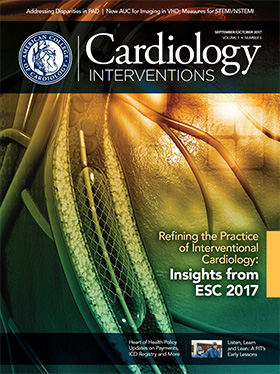The improvements in risk stratification for percutaneous revascularization as well as technical and procedural aspects of PCI since the SYNTAX I trial have reaped benefits. The SYNTAX II trial reported that contemporary treatment yielded better clinical outcomes at one year after PCI in patients with de novo triple-vessel disease compared with the SYNTAX I strategy.
The so-called state-of-the-art SYNTAX II strategy employed the new risk stratification tool that incorporates clinical and anatomical variables, second-generation drug-eluting stents (DES), physiology-based revascularization with a hybrid use of instantaneous wave-free ratio and fractional flow reserve, and IVUS-guided PCI. Improved PCI techniques for chronic total occlusion (CTO), developed since the SYNTAX I trial, and guideline-directed medical therapy were also part of the strategy.
The single-arm, open-label, prospective, multicenter trial included 454 patients in the SYNTAX II arm and 315 matched patients from SYNTAX I selected because of equipoise between CABG and PCI for mortality at four years.
In an exploratory analysis comparing the SYNTAX II patients with 334 CABG patients from SYNTAX I selected based on equipoise, the investigators showed noninferiority for the contemporary PCI strategy for MACCE (10.6 percent vs. 11.2 percent; HR, 0.91; p < 0.001 for noninferiority). Read More >>>
Other overall findings include significantly fewer lesions being treated with PCI using the contemporary vs. older strategy and significantly higher success rates for CTO revascularization with the SYNTAX II strategy. Using the SYNTAX II risk stratification for PCI treatment led to similar outcomes at one year in patients with high anatomical risk (SYNTAX score >22) as those with low anatomical risk (SYNTAX score ≤22).
Another study in the PCI and CABG arena – in patients with T1D and multivessel disease – found that CABG was associated with a lower risk of coronary heart disease mortality, MI and repeat revascularization compared with PCI.
Published in the Journal of the American College of Cardiology simultaneously with its presentation at ESC, these results extend the finding that CABG is better than PCI in previous studies including BARI, FREEDOM and SYNTAX from type 2 diabetes to T1D.
This registry study conducted in Sweden by Martin Holzmann, MD, PhD, et al., included 2,546 patients with T1D who had a first multivessel revascularization (73 percent with PCI) during the study period. From 1995 to 1999, most patients received CABG (62 percent), but thereafter the rates of CABG declined and by 2010 to 2013 PCI was the treatment in 98 percent of patients.
For the primary outcome of all-cause mortality, over the mean follow-up of 10.6 years, there was no significant difference between the strategies after adjustment (HR, 1.14). The annual mortality rate was 4.3 percent with CABG and 6.1 percent with PCI.
The rate of cardiovascular mortality was lower with CABG than PCI (2.1 percent vs. 2.9 percent), translating to a 45 percent higher risk with PCI after adjustment. For MI, these rates were 2.7 percent and 4.6 percent, respectively, with a 47 percent higher adjusted risk with PCI.
The risk of repeat revascularization was five-fold higher with PCI (1.9 percent with CABG vs. 20.1 percent with PCI). While the 30-day stroke rate was higher with CABG than PCI (1.9 percent vs. 0.8 percent) there was no difference in the long-term risk. Similarly, there was no difference between strategies for the long-term risk of heart failure.
The issue of stroke after revascularization continues to be a concern, yet individual studies are underpowered to detect significant differences between CABG and PCI. Data from a patient-level pooled analysis of 11 randomized trials reported by Stuart J. Head, MD, PhD, et al., found a higher rate of stroke with CABG than PCI over the follow-up in the studies and in a landmark analysis in the first 30 days.
Among the 11,518 patients, 293 strokes occurred. Over the five-year follow-up, the stroke rate was 3.2 percent post CABG and 2.6 percent post PCI (HR, 0.77; p = 0.027). Of the 5,753 patients who had a PCI, 1,518 received a bare-metal stent, 2,156 a first-generation DES and 1,978 a second-generation DES.
The stroke rates in the landmark analysis for 30 days and 31-1,825 days are shown in Table 1. As expected, mortality was higher in patients who had a stroke than those who did not with both strategies (31 percent vs. 8.6 percent with CABG; 28.1 percent vs. 10.8 percent with PCI; p < 0.001 for both). Notably, for both strategies, five-year mortality was higher in patients who had a stroke within the first 30 days (Table 2).
<<< Return to top




